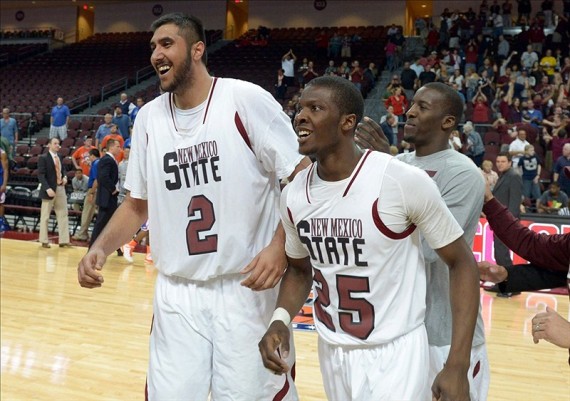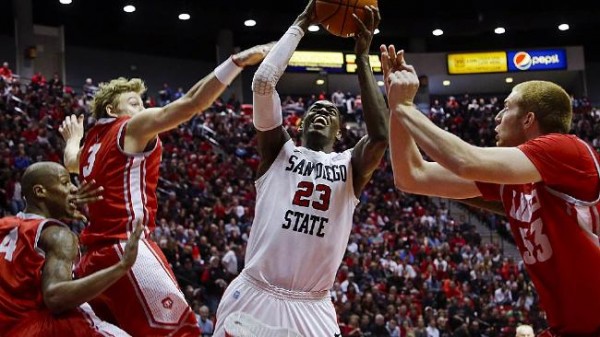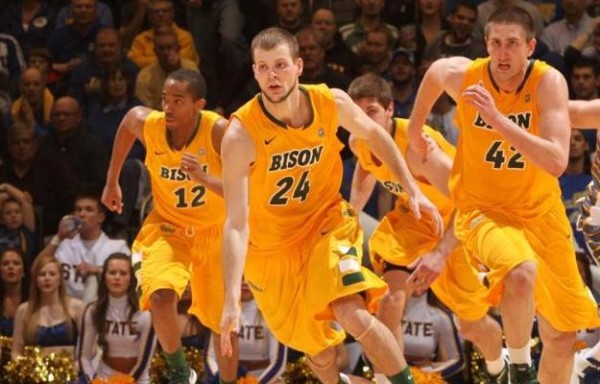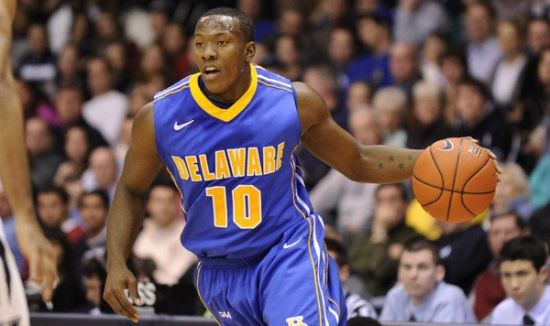O26 Bracketbusting: East and West Regions
Posted by Tommy Lemoine on March 19th, 2014The most joyous time of the year is finally upon us, and I’m not talking about tax season. I’m talking about buzzer-beating threes and scoring sprees, nickel-dimers and Nantz one-liners, back-door cuts and Farokhmanesh guts. I’m talking about the NCAA Tournament. And since O26 squads often make the most magic in March, let’s examine the prospects of each non-power conference unit in the upcoming Dance. Yesterday, Adam Stillman reviewed the South and Midwest Regions. Here, Tommy Lemoine looks at the East and West regions.
Regional Threats
These are the teams that have a legitimate chance to reach the second weekend, and perhaps even the Final Four.
- San Diego State (#4, West) – This is the fifth straight season San Diego State has reached the NCAA Tournament, but only once in that span has it advanced to the Sweet Sixteen. The good news for Aztec fans is that this is the best overall defensive unit – not to mention highest-seeded outfit – since 2011, the year Kawhi Leonard and company made that run to the second weekend. Steve Fisher’s club ranks seventh nationally in defensive efficiency thanks to long-armed perimeter defenders like Winston Shepard (he’s a 6’8’’ two-guard) and interior stalwarts like Skylar Spencer. The Aztecs are aggressive, confusing and energetic on that side of the ball. They draw New Mexico State on Thursday, a sizable and athletic #13 seed that’s both offensively proficient and does a good job defending the paint. But they turn the ball over quite a bit, and there’s a good chance SDSU will seize on that sloppiness, even if they have trouble scoring. In the following round, they would meet either Oklahoma or North Dakota State – two really efficient offensive squads that have both shown weaknesses this season against athletic, pressure defense. Both are beatable for the Aztecs. Finding success in Anaheim, though, might be a different story. The offense will need to be more consistent than it’s been up to this point, especially against a team like Arizona – the nation’s best defensive unit (and most likely Sweet Sixteen opponent). If Mountain West Player of the Year Xavier Thames can play like he did in January and early March – when he put up numerous 20-plus point performances – and complementary pieces like athletic wing Dwayne Polee can make solid contributions, SDSU would have a shot. But if they can’t find buckets with regularity, the Aztecs won’t last long.
- Gonzaga (#8, West) – It seems like everybody is sleeping on the Zags in favor of the ‘Marcus-Smart-can-make-a-run’ narrative, which is fine, and may very well happen. But do people realize that Mark Few’s bunch is ranked 20th overall in KenPom, with a top-15 defensive efficiency rating and a stellar effective field goal percentage? They might not be vintage Gonzaga, but these Bulldogs can still play. Their opening bout with Oklahoma State will probably be a good one – in fact, it has the highest ‘Thrill Score’ according to KenPom’s FanMatch – and should be winnable if they can contain Smart and limit turnovers. The experienced backcourt of Kevin Pangos, David Stockton and Gary Bell will help in the latter department. If they manage to get past the Pokes, a match-up with Arizona in the round of 32 would be daunting, of course, but not necessarily insurmountable. Consider this: Three of the Wildcats’ four losses this season came against opponents ranked in the top-30 in effective height. Gonzaga, with 7’1’’ Przemek Karnowski and 6’9’’ Sam Dower in tow, ranks 25th. Arizona’s Kaleb Tarczewski and Aaron Gordon will not be able to simply bully Few’s frontcourt into oblivion. If the big men hold their own and Pangos (41 percent) and Bell (42 percent) get hot from behind the arc, watch out. Admittedly, a deep run into the second weekend or the Final Four seems a bit farfetched for the WCC champions – especially considering their lack of quality wins in 2013-14 – but I’m not willing to completely push aside the possibility of a Sweet Sixteen run.
- Saint Joseph’s (#10, East) – The Hawks are a Sweet Sixteen threat because: 1) they enter the Dance brimming with confidence after rolling through the Atlantic 10 Tournament, and 2) every team in their pod is beatable. An opening game against Connecticut could turn into a really fun, back-and-forth, mano-a-mano affair between Saint Joseph’s guard Langston Galloway and Huskies guard Shabazz Napier, considering both take a high percentage of their teams’ shots and are capable of going on torrid scoring sprees. If the Hawks’ senior comes out hotter (he shot 5-of-8 from three on Sunday), that’s an immediate advantage. And even though UConn defends the paint very well, Martelli’s guys shoot well enough (and often enough) from the outside that consistent scoring should not be an issue. It might be close, and it could go either way, but the Huskies are beatable. If the Hawks do win, a potential round of 32 showdown with fellow Big 5 member Villanova is nothing the Hawks can’t manage, either. Sure, the Wildcats throttled Saint Joe’s by 30 back in December, but Jay Wright’s club has since looked vulnerable in Big East play, whereas this group seems to be a totally different, more confident team than it was three months ago. Martelli’s familiarity with his crosstown rival also can’t hurt. The Hawks have been a bit inconsistent down the stretch, so I’m not sure anything past the Sweet Sixteen is really doable – but two wins in Buffalo certainly is.
One and Done
These teams have a solid shot at winning their round of 64 game, but are unlikely to reach the second weekend.
- North Dakota State (#12. West) – North Dakota State is one of the most offensively efficient teams in the country, led by 6’7’’ guard Taylor Braun, who averages 18 points per game. He’s an efficient shooter (54.4 effective field goal percentage), draws a ton of fouls (top-100 in fouls drawn per 40 minutes and free throw rate), seldom turns the ball over, and is a capable of distributing. His frontcourt teammate, Marshall Bjorklund, is also hyper-efficient, while forward TrayVonn Wright flashes athletic ability not often seen at the mid-major level. They should be able to score against – to score with – Oklahoma on Thursday. The Sooners and the Bison are similar in that both teams are superior on offense and middle-of-the-pack on defense, but dissimilar when it comes to pace: Oklahoma is the 17th-most up-tempo unit in the country, while North Dakota State tends to slow things down and patiently look for the best shot available. The Summit League champions are the 23rd most experienced team in the country, while the youthful Sooners are 305th, so I think a controlled effort from Braun and company will make this #12-#5 upset entirely possible. Unfortunately, if they bump up against San Diego State in the next round, the Bison will be in trouble. A similarly-athletic and defensive-minded Ohio State squad romped NDSU in non-conference play back in December, and I can see the same thing happening in the round of 32.
- Harvard (#12, East) – Yes, Harvard shocked New Mexico last March as a #14 seed, but this year’s team might be even better. Seniors Kyle Casey and Brandyn Curry rejoined the fold in 2013-14 after sitting out all of last season due to an academic scandal, helping round out one of the deepest and most athletic units the Ivy League has ever seen. Their match-up with Cincinnati should be a gritty, grimy defensive affair – the Bearcats are ninth in the country in defensive efficiency, while Harvard is 33rd– but I like the Crimson’s excellent offensive balance to keep them in this one. Six different players average between nine and 14 points a game, and each seems to score in different ways. Point guard Siyani Chambers is smooth and seasoned and should be able to locate a hot hand – whether it’s sharpshooter Laurent Rivard or recent go-to Steve Moundou-Missi, a gifted forward – and generate enough buckets to hang with the stingy Bearcats. Guard Wesley Saunders might be the key for the Crimson, though. As Tommy Amaker’s most dynamic offensive player and best perimeter defender, Saunders will have to create shots when the going gets tough offensively, and do his darndest to slow down Sean Kilpatrick – Cincinnati’s most potent scorer – on the defensive end. This could be a coin flip, first-team-to-60-wins kind of game, and it would not be shocking if Harvard comes out on top. If the Ivy champs do notch their second NCAA Tournament win in two seasons, though, a third victory will probably have to wait at least another year: Michigan State most likely comes a-knockin’ on Saturday.
- Brigham Young (#10, West) – The Cougars lost their leading rebounder, leading assist man and second-leading scorer when Kyle Collinsworth tore his ACL during the WCC Tournament, so the ceiling on this team is undeniably lower than it otherwise would have been. More than one win seems unlikely. Still, BYU nearly knocked off Oregon back in December, narrowly losing by four in overtime, and I have a hard time believing that it can’t find enough offense to run with Dana Altman’s club once again. Plus, the Ducks haven’t exactly been bastions of consistency this season. The first meeting produced 196 points, and with a pair of offenses that rank among the fastest and most efficient in the country, one should expect another high-scoring outcome on Thursday. Cougars guard Tyler Haws is the nation’s sixth-leading scorer, an elite offensive player capable of finding buckets from anywhere on the court. A red-hot afternoon from him might very well mean the last game of the season for Oregon. But don’t expect BYU to do much beyond that.
- George Washington (#9, East) – Mike Lonergan has done a heck of a job with the Colonials this season, taking a 13-17 club last year and turning them into a 24-8 NCAA Tournament team in 2013-14. Indiana transfer Maurice Creek has helped turn things around, and so has the emergence of foreign frontcourt mates Patricio Garino – an athletic wing – and 6’10’’ Kevin Larsen. Along with former Villanova power forward Isaiah Armwood, these guys make up a well-balanced unit that can score in a variety of ways and likes to mix things up on defense. Interestingly, its statistical profile is remarkably similar to Memphis, its upcoming round of 64 opponent. Both are slightly better defensively than they are offensively; both force a fair amount of turnovers but turn it over at a high rate; both are above-average offensive rebounding teams but below average defensive rebounding teams; and both are identically awful from the free throw line (65.3 percent). With overall KenPom rankings of 45th (Memphis) and 46th (George Washington), it’s hard to predict what will happen on Friday. Which is to say, the Colonials have a reasonable chance – probably 50 percent – to win their first NCAA Tournament contest since 2006. If GW comes out on top, however, they might be in trouble against Virginia in the following round. The Cavaliers are very similar to A-10 champion Saint Louis – notable for their gritty, pack-line defense – and GW failed to score 60 points against the Billikens in each of their meetings the last two seasons, both losses. That probably means one-and-done for Lonergan’s bunch.
Slipper May Fit
These are teams that could pull an upset in the round of 64 if things go right.

New Mexico State might be able to knock off the Aztecs if things go right. (Kirby Lee-USA TODAY Sports)
- New Mexico State (#13, West) – The Aggies have the athleticism to hang and the frontcourt to bang with San Diego State, but the question is whether they can take care of the ball and maintain their composure against that vicious Aztecs defense. Unfortunately, the answer might be ‘no’ after news hit on Monday that K.C. Ross-Miller – who was suspended following an on-court brawl against Utah Valley a couple weeks ago – will not rejoin the team in 2013-14. He was New Mexico State’s leading assist man and one of its best ball-handlers. Still, the mammoth frontcourt of Tshilidzi Nephawe and 7’5’’ Sim Bhullar should enable the WAC champs to generate second-chance opportunities on offense and prevent easy looks in the paint on defense. If the Aggies take care of the ball and the Aztecs struggle to make shots, Marvin Menzies’ guys have more than a puncher’s chance. Remember – they beat New Mexico in The Pit this season… Steve Fisher’s club can’t say the same.
- North Carolina Central (#14, East) – Will this be the next MEAC school to deliver a March stunner? Well, it sure has the makeup for it. Levelle Moton’s Eagles come in having won 20 straight games, led by a big-time scorer in Jeremy Ingram and one of the best defenses you will find in a bottom-tier league. This is an experienced group – fourth-most experienced nationally, in fact – that’s proven capable of upending high-major, NCAA Tournament-caliber opponents; NCCU beat North Carolina State on the road back in November. Iowa State is not NC State, though, and the Eagles will probably have no chance if the Cyclones go on a massive three-point bender like they did against Kansas over the weekend. But if Ingram gets hot, NCCU can limit Iowa State’s transition attack and Fred Hoiberg’s guys go cold against the Eagles’ packed-in half-court defense, you never know. Coppin State? Hampton? Norfolk State, anyone??
- Louisiana-Lafayette (#14, West) – The slipper may fit, if only because UL-Lafayette has NBA-caliber talent on its roster. Elfrid Payton is a 6’3’’ point guard with tremendous quickness, able to beat people off the dribble and get to the rim with ease. His perimeter defense is also top-notch. Power forward Shawn Long, meanwhile, is a beastly rebounder and shot-blocker who can step out and shoot threes when he’s not making things happen down low. Both guys will present match-up problems for Creighton on Friday and should be able to put up points against their average defense and lack of superior athletes. Unfortunately – as good as Payton and Long are defensively – the Ragin’ Cajuns will likely have a hard time stopping, or even slightly containing, the Bluejays’ nation-leading offensive attack. Doug McDermott and company have not been held to under one point per possession since early February and should have no problem scoring against UL-Lafayette, which barely cracks the top-200 in defensive efficiency. Can Bob Marlin’s crew hang around with the Big East regular season champs? Sure. But it’s going to take a mammoth offensive and defensive effort from Payton and Long.
- American (#15, West) – This is unlikely to happen, and the mere mention of it might seem a bit crazy, BUT – if there’s a #15 seed that could knock off a two-seed this week, it’s probably American. I like the match-up against Wisconsin. Offensively, the Eagles have a serious turnover problem, but that should not be an issue against a Wisconsin defense that rarely forces those. The Badgers are great at taking away the three-point line and forcing opponents to shoot mid-range jumpers, but Mike Brennan’s group has the seventh-best two-point field goal percentage in the entire country. As for that grinding style Bo Ryan likes to play? American should have no problem with that, either: at 61.4 possessions a game, its adjusted tempo is 10th-slowest in the land. And although Wisconsin’s offense is exceptionally efficient, American boasts a very good defense with decent interior size and strength (center Tony Wroblicky is 6’10’’). Yeah, the Badgers might win handily, but if this becomes a low-scoring slugfest and the Eagles hit some shots, don’t be surprised if it’s very close in the waning minutes.
Enjoy Your Parting Gift
These squads are virtual locks to head home with nice memories an NCAA appearance, but not much else.
- Delaware (#13, East) – Head coach Monte Ross probably said it best when talking about Michigan State on Monday: “The biggest concern is that they’ll show up.” You have to feel for the Blue Hens, an offensively talented team that otherwise might have given someone trouble in the round of 64 with the right match-up. But when they saw the Spartans pop up on Selection Sunday, any real hopes of becoming Cinderella were probably dashed in an instant. Devon Saddler, Davon Usher and Jarvis Threatt might be able to hit some early shots and stick around for a half, but for a team that loves to get up-and-down and doesn’t put much emphasis on defense, I don’t like their chances against Tom Izzo’s bigger, faster, deeper unit. Big man Carl Baptiste will struggle to rebound at his usual rate – a problem for Delaware, which barely rebounds as it is – and I just don’t see the CAA champs coming up with enough stops to make a game of it.
- Coastal Carolina (#16, East) – Props to Cliff Ellis and his squad for winning the wide-open Big South Tournament and clinching an NCAA Tournament bid for the first time in 21 years. That’s cause for celebration. But the Chanticleers might want to enjoy it while it lasts, because although they were a halfway-decent defensive club this season, their offense is among the most inefficient in the country – a huge problem against Virginia. The Cavaliers do not allow opponents to penetrate the paint, and since Coastal is an especially poor three-point shooting team, I’m not sure how they will find enough points to keep this one competitive.
- Milwaukee (#15, East) – Milwaukee went on an improbable run in the Horizon League Tournament, notching road victories over prohibitive favorite Green Bay and Wright State to clinch the automatic bid. The unlikely trek probably ends there for Rob Jeter’s scrappy bunch, though. Unless they are clicking on all cylinders, Villanova’s great balance and depth will likely prove too much for the Panthers over the course of 40 minutes. Forwards Kyle Kelm and Matt Tiby have some size and aren’t lacking in confidence – both flashed demonstrative swagger throughout the conference tournament – but they might really struggle against the Wildcats’ solid interior defense. Jeter’s guards will have to knock down shots, and I just don’t seem them doing that on a consistent enough basis to advance.
- Weber State (#16, West) – Hey now, Weber State has good size, a first-rate offensive and defensive rebounder, and an excellent scoring guard who won conference player of the year. Watch out (for a half), Arizona! Unfortunately, unless Davion Berry – that excellent guard – can drop upwards of 40 points against the nation’s top defense, the Big Sky’s Wildcats probably won’t last more than 20 minutes against the Pac-12’s Wildcats.













































